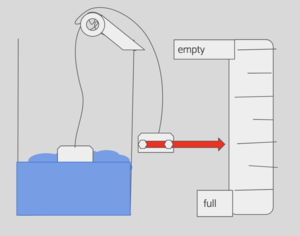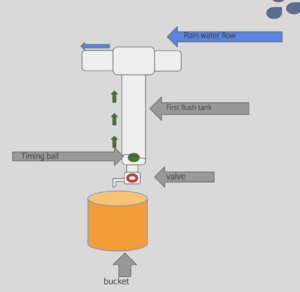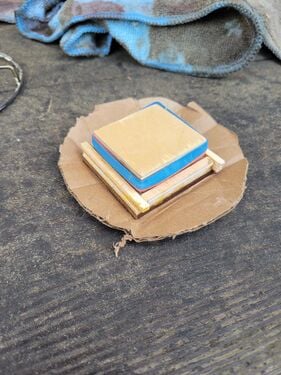
"No, In progress" is not recognized as a Boolean (true/false) value.
The objective of The Cistern Sisters design project is to repair and maintain the main rainwater catchment system at CCAT. The Cistern Sisters will rebuild the first flush, collecting and discarding the first 10 minutes of rainwater collected, Rebuild the lid of the cistern using the current materials on the lid and materials provided for free by CCAT. And finally add a depth meter for the cistern allowing members of CCAT to check and monitor the amount of water in the cistern at any given time. The upgrades to the cistern should be prioritized to be low-cost, effective, and educational.
Background[edit | edit source]
The water Cistern at CCAT (Campus Center for Appropriate Technology) has problems pertaining to first flow release and measurements on its main rainwater catchment system, more specifically, the main collection cistern. CCAT’s mission statement is to demonstrate that “Living lightly on the Earth is both practical and rewarding” The Cistern Sisters aim to maintain and uphold the mission of CCAT while meeting and achieving CCAT’s goals on the water cistern upgrade.
The Cistern Sisters is a team of four Engineering students of all disciplines at California Polytechnic State University, Humboldt. Our members, Toby Dupras, Gavin Compagno, William Ferguson, and Trevor Liepa formed this team in spring 2024 to tackle design challenges in the Engineering 205 Into to Design course.
Problem statement[edit | edit source]
The main rainwater catchment system at CCAT had no working first flush, a disposable cheap lid and no way to measure depth in the cistern.
Criteria[edit | edit source]
Include a brief intro to the criteria and then include a table with constraints and weights (0-10 highest).
| Criteria | Description | Weight (1-10) |
|---|---|---|
| Functionality | First flush system efficiently collects the first 10 min of rainwater to ensure clean water in the cistern; Cistern depth meter is accurate and robust. | 10 |
| Aesthetics | Look as good or better and similar to the design in To Catch the Rain | 9 |
| Level of Educational | A sign is in place that properly conveys how a first flush works and what it does | 8 |
| Cost | Limited to $500 total ($200 from CCAT, and $75 from each group member) | 7 |
| Ease of Upkeep | First flush and depth meter are as robust as possible to reduce needed upkeep in the future | 7 |
| Eco-Friendliness | Built using as many secondhand parts or recycled materials from the Resource Reclamation Station as possible. | 6 |
| Safety | The first flush and depth meter are solidly attached, and the cross pipe cannot fall off the beam | 6 |
| Theft Resistance | The first flush system and bucket will be difficult at best to steal to reduce chance of theft. | 3 |
Prototyping[edit | edit source]
We prototyped the different parts of our solution for the client in terms of functionality and desire.
- Prototype photos
-
Our initial prototype for the cistern lid.
-
Initial prototype for the cistern water level indicator.
Final product[edit | edit source]
The rainwater catchment system at the CCAT facility on the upper slopes had a jar in place of a first flush system. We removed the old pieces of the first flush system that were not functional and implemented a new first flush now equipped with a view port and valve to view water levels and empty the first flush. The next item on the repair and upgrade list was the lid, which used to be a trash can lid held down by wood scraps. The cistern is now covered with a lid from ace hardware that we inserted and fixed a rubber O-ring substitute into for water sealant. It is very useful to know how much water is in a container, and the system used to have no external way to view and measure water levels. Now with the pool float attached to the string that runs out of the cistern and down the side wall, you can measure the water level using an inverted marker that correlates to the water level inside.
Inspirational Video[edit | edit source]
Bill of materials[edit | edit source]
Description of costs, donations.
|
|---|
Operation[edit | edit source]
The water cistern and first flush system is fully self-operational. Maintenance will be required. However, because of the use of flotation in our designs, all you need to know for the first flush is that a ball gets pushed up by dirty water and eventually plugs the first flush pipe, redirecting what should be clean water into the cistern. For the lid you just have to make sure the O-ring seal is properly attached and there are no leaks. For the water level indicator just remember that the closer the indicator is to the ground, the more full the cistern is, and when the cistern is empty the indicator will be more towards the top.


Maintenance[edit | edit source]
The Cistern Sisters do not foresee any planned maintenance costs. However, in the event of a need for maintenance, the costs should be relatively low compared to the implementation cost. The maintenance schedule below describes what we predict will be some trivial tasks to promote the upkeep of the system.
Maintenance schedule[edit | edit source]
This is when to maintain what.
- Daily
- Observe depth meter as to confirm it is still floating
- Weekly
- When rain occurs confirm the first flush system still works
- Monthly
- Check the lid to make sure it is still securely attached to the cistern
- Yearly
- Replace the string connecting the float to the depth measurement system
- Clear the gutters of the rain water catchment system
- Confirm there is no algae growth in the first flush via the viewport
- Every 5 years
- Repaint the depth measurement system
Troubleshooting[edit | edit source]
This is only how to troubleshoot basic operation.
| Problem | Suggestion |
|---|---|
| First flush overflow | Empty the connected bucket |
| Lid not securing | Firmly press in on the lid, if it isn't catching/sealing at all replace the bike tube |
| Depth measurement snapped off | Replace string and retie it to inner float |
| Bucket stolen | Buy another bucket |
| First flush de-attaches | It can be reattached with new fittings costing roughly $10-15 dollars. |
| First flush de-attaches and the system is heavily damaged | Contact tl182@humboldt.edu |
| Algae in the tube | Contact tl182@humboldt.edu |
Team[edit | edit source]
The Cistern Sisters - Spring 2024 - Engr 205
- Trevor Liepa
- Toby Dupras
- Gavin Compagno
- William Ferguson
References[edit | edit source]

